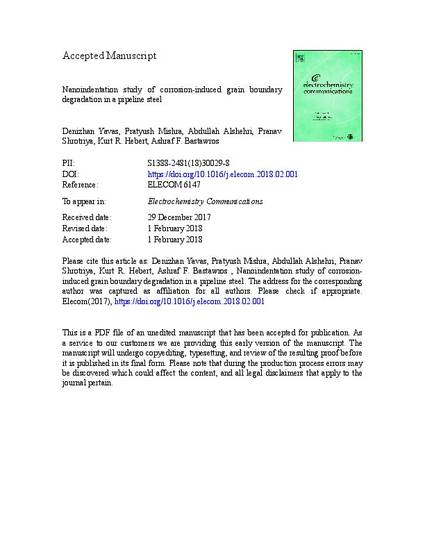
Article
Nanoindentation study of corrosion-induced grain boundary degradation in a pipeline steel
Electrochemistry Communications
Document Type
Article
Disciplines
Publication Version
Accepted Manuscript
Publication Date
3-1-2018
DOI
10.1016/j.elecom.2018.02.001
Abstract
High-strength low-alloy steels used for oil and gas pipelines are vulnerable to intergranular stress corrosion cracking in moderately alkaline soils. The mechanism of corrosion-induced embrittlement under such conditions is not yet understood. Nanoindentation was used to detect localized degradation of mechanical properties near internal grain boundaries of X-70 steel undergoing intergranular corrosion at active dissolution potentials at pH 8.2. The measurements identified a one-micron thick mechanically-degraded layer with 25% reduced hardness near corroded grain boundaries. It is suggested that the corrosion process may introduce an active softening agent, possibly non-equilibrium lattice vacancies generated by oxidation.
Creative Commons License
Creative Commons Attribution-Noncommercial-No Derivative Works 4.0
Copyright Owner
Elsevier B.V.
Copyright Date
2018
Language
en
File Format
application/pdf
Citation Information
Denizhan Yavas, Pratyush Mishra, Abdullah Alshehri, Pranav Shrotriya, et al.. "Nanoindentation study of corrosion-induced grain boundary degradation in a pipeline steel" Electrochemistry Communications Vol. 88 (2018) p. 88 - 92 Available at: http://works.bepress.com/kurtr_hebert/52/

This is a manuscript of an article published as Yavas, Denizhan, Pratyush Mishra, Abdullah Alshehri, Pranav Shrotriya, Kurt R. Hebert, and Ashraf F. Bastawros. "Nanoindentation study of corrosion-induced grain boundary degradation in a pipeline steel." Electrochemistry Communications 88 (2018): 88-92. doi: 10.1016/j.elecom.2018.02.001. Posted with permission.